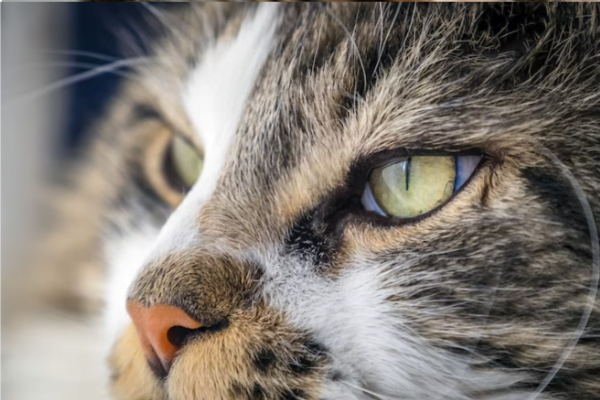Eye Diseases in Cats: A Complete Guide
Did you know that cats can also develop eye diseases? Although these diseases may go unnoticed by many cat owners, it is crucial to be aware of the signs and symptoms to ensure your pet feline's eye health. In this comprehensive guide, we'll explore a variety of eye diseases in cats, their symptoms, causes and treatments. We'll learn how to keep your cat's eyes healthy and sparkling. Let's begin our journey through the world of Eye Diseases in Cats:
Eye Diseases in Cats: An Overview
In this section, we'll give you an overview of the eye diseases that can affect cats. Understanding the most common problems is the first step towards protecting your cat's eyesight.
Cats are susceptible to various eye diseases, including:
Contents
1. Feline conjunctivitis
Conjunctivitis in cats is an inflammation of the conjunctival membrane of the eye. It can be caused by viral or bacterial infections or allergies. Symptoms include red, watery eyes and eye discharge.
2. Corneal ulcers
Corneal ulcers are sores on the cornea of the eye and can be painful for cats. They are often caused by trauma, such as scratches, or infections.
3. Glaucoma
Glaucoma is a serious condition that affects eye pressure. It can lead to blindness if not treated in time. Symptoms include red, dilated and painful eyes.
4. Cataract
Just as in humans, cats can develop cataracts, an opacification of the lens of the eye. This can affect a cat's vision and requires surgery in advanced stages.
5. Entropy
Entropion is a condition in which the cat's eyelid turns inwards, causing constant irritation to the eye. This can lead to corneal injuries.
Symptoms of Eye Diseases in Cats
Now that we know some of the eye diseases in cats, it's important to know how to identify the warning signs. Recognizing early symptoms is essential for effective treatment.
Some common symptoms include:
- Frequently watery eyes.
- Red or inflamed eyes.
- Changes in eye behavior, such as excessive scratching.
- Excessive blinking.
- Abnormal eye discharge.
- Changes in the color or clarity of the eye.
Causes and Risk Factors
Understanding the causes and risk factors of eye diseases in cats is fundamental to preventing their development. Here are some of the most common causes:
- Viral and Bacterial InfectionsMany eye diseases are triggered by infections, such as feline herpesvirus.
- Ocular traumaPhysical injuries, such as scratches or knocks, can lead to corneal ulcers.
- Advanced ageOlder cats are more likely to develop cataracts.
- Genetic predispositionSome breeds of cat have a genetic predisposition to certain eye diseases.
Diagnosis and treatment
If you notice any symptoms of eye disease in your cat, it is crucial to go to a veterinarian specializing in feline ophthalmology. Early diagnosis is vital for effective treatment. Vets use a variety of diagnostic methods, such as eye examinations and eye pressure tests.
Treatment will depend on the specific disease, but may include:
- MedicinesAntibiotics, eye drops and anti-inflammatories may be prescribed.
- SurgeryIn severe cases, such as advanced cataracts, surgery may be necessary.
- Underlying treatmentIf the eye disease is caused by an underlying condition, that condition should also be treated.
Prevention of Eye Diseases in Cats
Prevention is the best approach to keeping your cat's eyes healthy. Here are some tips to help prevent eye diseases in cats:
- VaccinationsKeep your cat's vaccinations up to date to prevent viral infections.
- Safe EnvironmentAvoid giving your cat access to dangerous areas that could cause eye damage.
- Balanced diet: Feed your cat a balanced diet to maintain its general health.
- Eye hygiene: Clean your cat's eyes regularly to remove dirt and debris.
FAQ about Eye Diseases in Cats
What is feline conjunctivitis?
Feline conjunctivitis is an inflammation of the conjunctival membrane of the eye, usually caused by viral or bacterial infections or allergies. Symptoms include red, watery eyes.
How can I prevent eye diseases in cats?
Prevention includes regular vaccinations, maintaining a safe environment, proper nutrition and eye hygiene.
What are the common symptoms of eye diseases in cats?
Common symptoms include watery eyes, redness, excessive itching and changes in eye behavior.
Are older cats more prone to eye diseases?
Yes, older cats are more likely to develop cataracts and other age-related eye diseases.
Is surgery always necessary to treat eye diseases in cats?
No, treatment depends on the type and severity of the disease. In some cases, medication may be sufficient.
Can I clean my cat's eyes at home?
Yes, you can carefully clean your cat's eyes with a clean cloth and warm water, but consult a vet if there are signs of infection.
Conclusion
Protecting your cat's eyesight is an essential part of pet care. Keep an eye out for signs of eye disease and take preventative measures to keep your cat's eyes healthy. Remember that proper veterinary care is crucial for proper diagnosis and treatment. With proper care, you can help your cat enjoy clear, healthy vision for many years to come.
If you liked this informative guide on Eye Diseases in Cats, please leave a comment.
Thanks for stopping by, check out our other work too
https://cuidar.petlove.com.br/cachorro/brinquedos
https://vettopbr.com/tosse-em-caes/







